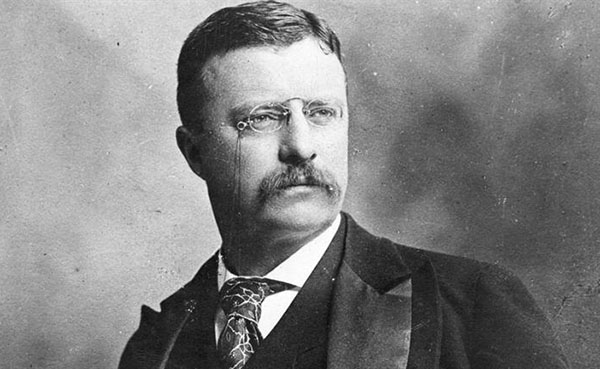Only four vice presidents that filled out the term of a deceased chief executive would win reelection in their own right and all four lived in the 20th Century.
During the Nineteenth Century, four vice presidents succeeded to the Presidency upon the death of the Chief Executive yet none of these men were successful in achieving reelection. John Tyler, Millard Fillmore, Andrew Johnson, and Chester Arthur were rejected by their parties for a second term nomination. In the Twentieth Century, however, all four vice presidents completing the term of a president that died while in office successfully achieved reelection in their own right.
Theodore Roosevelt
Roosevelt became president upon the death of William McKinley, who was assassinated in 1901. Although at odds with the Republican “Old Guard,” the Stalwarts that controlled the Senate, Roosevelt enjoyed tremendous support from the American people. With an aggressive, “no-nonsense” leadership style, he ended the 1902 Anthracite Coal Strike. Roosevelt was keenly attuned to the pulse of American citizens, a progressive warrior with a heroic personal history.
Roosevelt’s 1904 victory marked the first time that a vice president who had assumed the presidency would be returned to office. The extent of that victory also allowed him to shepherd progressive legislation through the Congress while expanding the scope of American foreign policy initiatives such as the Roosevelt Corollary to the Monroe Doctrine, building the Panama Canal, confronting Imperial Germany over Venezuela, and mediating an end to the Russo-Japanese War.
Calvin Coolidge
Coolidge became president upon the death of Warren G. Harding in August 1923 and was reelected in 1924. He was conservative in all matters and voters responded to his managerial style. He “never wasted any time, never wasted any words, and never wasted any public money,” quipped one political leader at the nominating convention. Coolidge presided over an expanding economy and several years of prosperity.
Harry Truman
FDR’s fourth vice president, Truman led the nation out of a horrific world war and into another. Both the Cold War and American involvement in Korea in 1950 was seen as necessary in order to defend democracy against Communism. Although the 1948 election was close and Thomas Dewey was the predicted victor, Americans returned Truman because he was seen as tough on Communism. Domestically, his charge of a “Do Nothing Congress” appealed to voters.
Lyndon B. Johnson
In November, 1963, President John F. Kennedy was assassinated in Dallas, Texas and Johnson was sworn into office shortly thereafter aboard Air Force One. Unlike Kennedy, Johnson had many more years of service in the Congress and would be able to achieve spectacular legislative results particularly in areas of Civil Rights, environmental concerns, and the war on poverty.
By the 1964 November general election, the Gulf of Tonkin Resolution had already been passed by a Congress willing to give a blank check to the Chief Executive in order to stop the menace of expanding Communism. Although Johnson’s opponent was also a virulent Cold Warrior, Barry Goldwater was depicted as too extreme, a potential Commander in Chief who might initiate a nuclear war. Johnson was the last vice president to be elected to his own four year term.
Summary
Gerald Ford was the last president to follow a sitting president, however, that appointment resulted from a presidential resignation and Ford was not elected to another term. Not fitting the 20th Century pattern, his experience was somewhat unique.
Unlike 19th Century vice presidents that filled out terms, 20th Century vice presidents in the same capacity were viewed as strong leaders during times of domestic and/or international turmoil. Although Coolidge may be the exception, the nation in 1924 was doing well economically and was at peace, two good reasons for staying the course.








